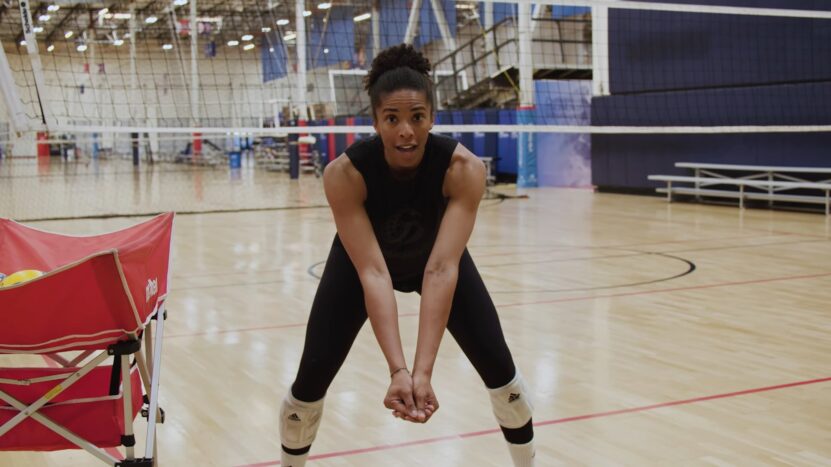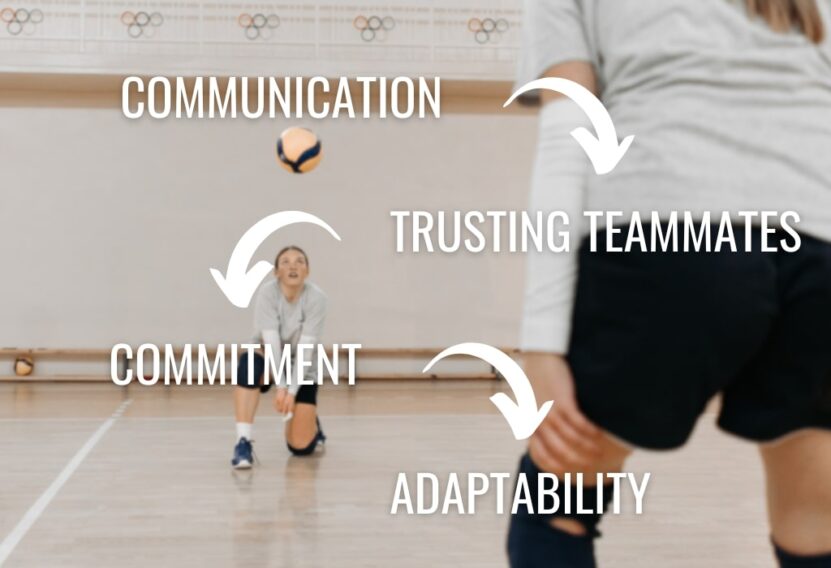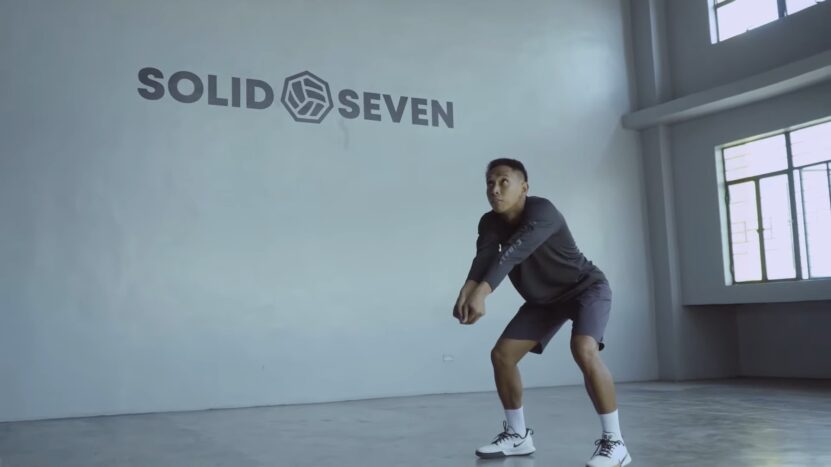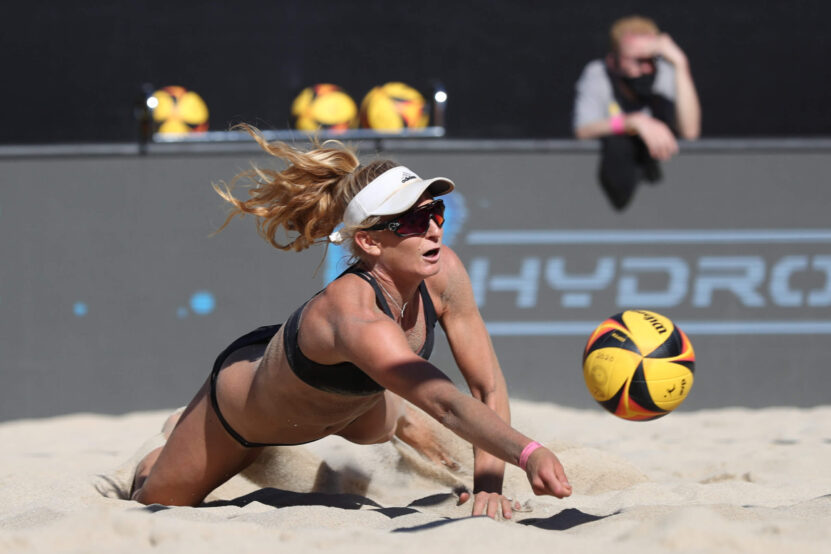Imagine this: A volleyball rocketing towards the floor at breakneck speed, and out of nowhere, a player lunges forward, hand extended, and makes contact. The ball springs back into play, the crowd gasps, and the point continues. This incredible feat is known as the dig, and it’s an essential skill for any volleyball player to master.
In this article, we’ll explore the fascinating world of digs in volleyball. We’ll cover the basics of what a dig is, the techniques and strategies behind executing an effective dig, and the importance of this often underappreciated skill in the grand scheme of the game. Join us on this deep dive into the world of digs, and you’ll leave with a newfound appreciation for this crucial aspect of volleyball.
Dig in Volleyball Explained
A dig is a defensive maneuver in volleyball, used to prevent the ball from hitting the ground and to keep the play alive. When executed correctly, a dig can be a game-changer, turning a seemingly lost point into a new opportunity for your team to score. Digs typically occur when a player receives a powerful attack or a serve from the opposing team. The player “digs” the ball, ideally passing it to their team’s setter, who can then orchestrate an offensive play.
In essence, a dig is the first contact made with the ball in a defensive situation, and it sets the stage for the rest of the play. A well-executed dig is essential for a team’s success, as it can quickly turn defense into offense and keep the opposing team on their toes.
The Fundamentals of Digging

A successful dig relies on a combination of good positioning, quick reflexes, and proper technique. Let’s break down the fundamentals of digging to better understand how players can elevate their game.
Positioning
To effectively dig a ball, a player must be in the right place at the right time. This requires anticipating the opposing team’s movements and adjusting accordingly. Good positioning involves staying low, maintaining a wide stance, and being prepared to move quickly in any direction.
Reading the Attacker
To anticipate where the ball will go, players must read the attacker’s body language and movements. By paying attention to the attacker’s approach, arm swing, and point of contact with the ball, players can predict the ball’s trajectory and react accordingly.
Platform and Angle
When digging, players should present a stable platform with their forearms, ensuring that their hands are together and their elbows are locked. The angle of the platform is crucial, as it determines the direction in which the ball will travel. Ideally, players should angle their platform towards their team’s setter, facilitating a smooth transition to offense.
Footwork and Body Control
Quick, efficient footwork is key to getting in position for a dig. Players should practice shuffling and crossover steps, allowing them to cover the court effectively. Additionally, controlling the body during a dig is essential, as it ensures stability and accuracy. Players should aim to stay low and maintain their balance throughout the dig.
Strategies for Effective Digging

Now that we’ve covered the fundamentals of digging, let’s delve into some strategies that can help players elevate their game.
Communication
In volleyball, communication is key. Players should consistently call out the ball’s location and trajectory, ensuring that their teammates are aware of the play’s progression. This not only prevents collisions but also allows for a seamless transition from defense to offense.
Trusting Teammates
In high-pressure situations, it can be tempting for players to try and cover the entire court themselves. However, this can lead to inefficiency and fatigue. Trusting your teammates to cover their respective areas of the court allows each player to focus on their specific role, ultimately leading to better overall team performance.
Commitment
When digging, players should commit fully to the action. This means not hesitating or second-guessing their movements, as doing so can result in missed opportunities or poor execution. By committing to the dig, players demonstrate confidence and determination, which can be contagious and inspire their teammates to do the same.
Adaptability
No two digs are exactly alike, so players must be prepared to adapt to various situations. This can involve adjusting their platform angle, using different footwork patterns, or altering their body position to accommodate the ball’s speed and trajectory. By remaining adaptable, players can handle a wide range of defensive scenarios and ensure their team’s success.
The Importance of Digs in Volleyball

Digs may not garner the same attention as powerful spikes or flashy sets, but their importance in volleyball cannot be overstated. Let’s explore some of the reasons why digs are essential to the game.
Momentum Shift
An exceptional dig can change the momentum of a game, turning a seemingly lost point into a new opportunity for your team. This can be demoralizing for the opposing team and provide a much-needed boost in morale for your own side.
Defensive Prowess
A team that excels at digging is difficult to score against, as they can consistently return the ball and thwart their opponent’s attacks. By mastering the art of digging, a team can establish a strong defensive foundation and become a formidable force on the court.
Versatility
Players who excel at digging are valuable assets to their team, as they can contribute both defensively and offensively. A well-executed dig can lead to a seamless transition to offense, allowing your team to capitalize on the opportunity and score points.
Team Unity
Successfully executing a dig requires teamwork, communication, and trust among teammates. When players work together to save a difficult ball, it fosters a sense of unity and camaraderie, which can translate to improved performance on the court.
The Role of Liberos in Digging
When discussing digs in volleyball, it’s essential to highlight the position of libero, a defensive specialist whose primary responsibility is to excel at digs and keep the ball in play. Let’s take a closer look at the unique role liberos play in digging.
Back-Row Expertise
Liberos are back-row specialists, meaning they focus on receiving and digging balls from the opponent’s attacks. Their quick reflexes, exceptional positioning, and keen ability to read the attacker make them a vital asset to their team’s defense.
Substitution Rules
Liberos can freely substitute for any back-row player without counting towards the team’s substitution limit. This unique rule allows coaches to maximize their libero’s defensive contributions while preserving their other players’ energy for offense.
Serve Receive
In addition to digging, liberos are often responsible for serve reception. Their ability to consistently deliver accurate passes to the setter is crucial for a smooth offensive transition and can set the stage for a successful attack.
Leadership
Although liberos may not score points through attacks or blocks, they play a critical leadership role on the court. Their defensive prowess, combined with effective communication and a deep understanding of the game, enables them to guide their teammates and make strategic decisions that benefit the team.
Training Tips for Improving Your Digging Skills
To become a more effective diggers, players should dedicate time and effort to improving their skills. Here are some training tips that can help players hone their digging abilities:
1. Wall Drills
Practicing digs against a wall is an excellent way to work on platform angle, hand positioning, and reaction time. Players should stand close to the wall, toss the ball against it, and dig the rebound, adjusting their platform to direct the ball back to the wall. This drill can be performed solo or with a partner.
2. Reaction Drills
To improve reaction time and footwork, players can participate in reaction drills. These involve a partner tossing balls from various angles and at different speeds, forcing the player to react quickly and adjust their positioning to dig the ball successfully.
3. Target Practice
Setting up targets on the court and aiming for them during digging drills can help players refine their accuracy and consistency. Players should focus on directing their digs toward the target, which should represent the team’s setter or another specific location on the court.
4. Video Analysis
Studying game footage, either of oneself or of professional players, can provide valuable insights into digging techniques and strategies. By analyzing the video, players can identify areas for improvement and emulate the skills of elite diggers.
Digging in Beach Volleyball

Although this article has primarily focused on indoor volleyball, digging is equally important in beach volleyball. The basic principles of digging remain the same; however, there are some unique challenges and adaptations specific to the beach game:
Playing Surface
The sand’s uneven and shifting nature can make footwork and positioning more challenging in beach volleyball. Players must learn to move efficiently in the sand and adjust their digging technique to compensate for the unstable surface.
Two-Person Teams
Beach volleyball teams consist of only two players, increasing each individual’s responsibility for digging. This requires heightened communication, anticipation, and versatility, as both players must contribute defensively and offensively.
Wind and Weather
Outdoor elements, such as wind and sun, can impact a player’s ability to dig effectively in beach volleyball. Players must learn to adapt to these conditions and adjust their technique accordingly.
Final Words
The dig is a crucial aspect of volleyball, one that often goes unappreciated but plays a significant role in a team’s success. By understanding the techniques and strategies behind effective digging, players can elevate their game, contribute to their team’s defensive prowess, and help shift the momentum in their favor.
So, the next time you watch a volleyball match or step onto the court yourself, take a moment to appreciate the unsung hero of the game: the dig. With practice, commitment, and an understanding of the nuances involved, any player can become a digging powerhouse and make a substantial impact on their team’s performance.

